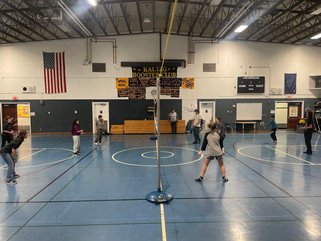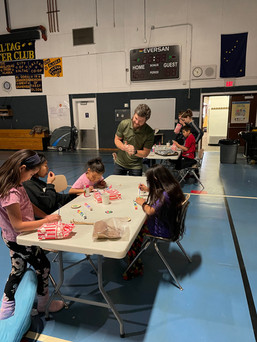Puppies, Potential, and Problematic Policies
- Prof C
- Dec 18, 2023
- 10 min read
-Philip
When I was a young boy, my maternal grandfather, whom we all called Pa, had come into possession of a dog named Bo. Now I’m not sure what the appeal of this dog was, but I took a liking to Bo and he to me. Bo was a midsize black and brown dog with a stub tail, and I’d be lying if I attempt to relay his specific breed. For whatever reason, though, Bo and I were instant mates. Noticing the connection (or just wanting to rid himself of the dog) Pa offered me the opportunity to take Bo home and keep him as my own. I was elated and, for the very first time, I had a pet of my own.
The problem with puppies, however, is that they are a bundle of unharnessed energy. This is why untrained dogs can be such a problem and why we have such an epidemic in America of puppy love, soured to unwanted frustration, as shelters are filled with those once cute bundles of energy. However, when properly stewarded, a dog can become a lifelong companion. For a variety of reasons, the dog is known as “man’s best friend,” instead of a host of other contenders. The cat is too unpredictable and always seems to be plotting the demise of their human. The cow is a great producer, but not a great pet. The snake just creeps most people out, and I’m not sure about the sanity of those individuals who keep rodents as pets. Nay, the dog, tops the list and comes in as the number one overall pet and companion.
This past week our school was visited, quite frequently, by a little puppy from the village. This pup took to standing just outside of the front door to the school and whining as students trampled up the ramp, in their oversized snow gear, in hopes that students would let him in. Even when the students tried to keep the puppy out, they often were unsuccessful, as the weight and size of their snow gear restricted their mobility while also requiring the door to be open wide for their entry. Time after time, this little pup outsmarted each of our students and, once inside, pounced upon the place with unbridled curiosity. We’d be in class and in came the puppy. We’d be sitting at breakfast or lunch and the pup would dart into the gym (where we eat) and run all the way across the gym to tyrannize individuals trying to eat.
Time and time again, the puppy found a way in, and time and time again we had to put him back outside into the cold, which was notably difficult because it’s a cute little puppy and it’s -10 degrees outside. Every time we told the students to take the puppy back outside, they looked at us like we were sentencing the puppy to some Siberian work camp. Obviously, such cruelty could not be tolerated by the students and forces of resistance began to emerge. First, protestations regarding the innocence of the puppy, its innocuous nature, along with (most importantly) it’s cuteness. When such protestations fell on the deaf ears, (since the puppy posed a very different reality to us seasoned folk than it did to a group of adolescents), students started to organize efforts to stash the puppy in hiding and keep watch for the Gestapo bent blindly on its removal. Time after time, the puppy would show back up and each time the students would levy a defense. All in all, it was quite humorous and although the puppy had to be removed each time, we were more endeared by the students’ efforts than dismayed.
When Ash and I embarked on our transition to teaching in rural Alaska, advice seemed to flow from all directions; guidance regarding what to expect, what to take, what to wear, what the school was going to be like, etc. Among this advice was a consistent flow that cautioned us to temper our expectations for the demographic with which we were about to engage. It was often quipped (and still is), “kids are just different out there.”
I questioned this assertion coming into the job and I question it still. Over the course of my education and professional experience, I’ve come to believe in a certain universality of things, of people. Concepts such as the protection of the innocent and the relative cuteness of puppies seem to transcend cultural boundaries and economic prejudice. In a sense, though my time here has been short, I have found no rationale to the claim that, “students are just different.” In fact, I’ve discovered quite the opposite and am compelled to stay the course regarding my expectations and hopes in what this school and these students can become.
Ironically, though many advice-givers are quite quick to argue that students are different, even here in Bush Alaska, I’m finding the same bad assumptions, bad policies, and bad logic are what hamstring an otherwise brilliant human potential held hostage by some expert’s ego and doctoral thesis. Three-thousand miles North of Central Texas, educational “experts” continue to levy their untested assumptions, founded upon their lack of experience, on students whom they have never met nor with whom they care to spend much time. Teaching is hard and such ill-founded efforts, often in pursuit of higher salaries, only complicate the day-to-day struggles that average classroom teachers face. While educational elites bathe themselves in outcome-based data, compared to generalized standards and national expectations, the average teacher has to manage drug addiction, divorce, trauma, stress, poor nutrition, lack of sleep, abuse, neglect, contempt, social disfunction, emotional retardation, vanity, ignorance, shame…and a host of other factors that will never show up in the outcome-based data. Putting a “learning target” on my board is not going to magically alter the emotional scarring of recent trauma and I have found no evidence to correlate the amount of time spent developing a highly detailed lesson plan and the level of student performance. Yet…these are too often the focus of educational elites whose only time in the classroom was a stopgap towards higher pay or greater authority.
Granted, none of us are immune to such oversight or ill-preparation. Part of the nature of existence is that we are born ignorant, immature, and lack necessary insight to make sound decisions. In my case, I have made many errors along my journey which has caused several undesired outcomes. In the case of my first pet, Bo, I learned a tough lesson early. Bo had gotten used to walking with me down our long driveway to the bus stop each morning and hang out with me while I waited on the bus. Once I was on the bus, he would return down the driveway to our home, and remain there until the end of the school day, when he would run and greet me after spotting me walking down the driveway after school. The problem, though, is Bo had a ton of energy and I was naïve of the need for his proper training. As we waited on the bus each morning, Bo had a certain tendency of barking at every car that drove by. I’m not sure if it was an effort to protect me or just an expressed energy at barking at the unknown, but it was not desirable and, as I noted, I was young and naïve to the potential danger.
One morning when I was in the third grade, Bo and I walked to the bus stop as usual, just like any other day and Bo, as usual, barked at every car that passed. With each one he would run further and further into the road as he barked, until the inevitable calamity descended upon him in the form of a silver sedan. I watched from the side of the road as he was struck, thrust to the side of the vehicle, and left unmoving, bleeding out. The driver of the car stopped, backed up and got out to see what had happened. She was a well-dressed, middle-aged woman, most likely on her way to work, and I remember her concern being, primarily, that of being late to work. Bo had interrupted her day and caused her to be later than she already was. I stood in disbelief as she apologized to me, got back into her car, and left. I was in the third grade.
I was left confused and angry, and the dominant thought cycling through my head was that if I left Bo there, in the middle of the road, he would only be hit again and again. I couldn’t stomach that idea. I walked to the middle of the road, grabbed my dismantled pet, and drug him to the side of the road where he could rest undisturbed. Shortly after, the bus pulled up, the door opened, and I got on to go to school…where I would be educated. All I remember from that day is my teacher noticed something off about me (as I was not my usual high-performing self) and, out of concern, sent me to the nurse’s office to get checked out. I must have missed the learning target.
The hardest lesson I’ve learned as a teacher is that we must balance a delicate exchange between our ever-present expectations and the reality of the next reasonable step our students can make. From my perspective, two schools of thought are dominant within education. On the one hand, you have the hardened educators cast in the mold of a Prussian officer who swears that discipline, routine, and harsh penalties are the way to maturation and growth. On the other, you have those who are more Rousseauan, who hold a pre-Marxist belief that each student will naturally grow and develop so long as the soil is fertile, and the child is protected, loved, and allowed to explore and grow at their own pace. Both approaches are foolish and if we, as educators, do not learn to synthesize these approaches, we’ll only continue to poorly steward the lives entrusted to our care.
After two months here in Alaska, I cannot say for certain that my students are able to read or write any better than when I arrived. I also cannot say whether any of my students are more likely to go to college, secure a gainful career, or secure a higher level of satisfaction (all measures educators like to focus on). However, though the growth we have observed is not usually measured by academic elites, it is no less obvious or imperative to their personal development and our collective maturation. As we continue to teach, we must continue to hold our students accountable for their own daily growth and development, but we must not let ourselves become blinded to the reality that not all growth carries a specific academic, measurable outcome. As educators, it’s how we check the small things, how we discipline consistently, and how we engage each day that matters. It’s whether we elevate our students to our status as equal human beings or, like far too many, demean them as projects in need of a savior, a handout, or an IEP. We simply should not make a student feel less because they do not meet our academic expectations. We also should not allow students to feel comfortable in their immaturity and self-infliction.
I suppose the lesson here wraps back to puppies. We love them. We are energized by them. We are frustrated by them. We are harassed by them. We are comforted by them. But the reality is that some puppies, regardless of age, are ready to be trained to fetch, sit, or retrieve fowl, while other puppies just need to learn not to run in front of cars. Small wins are wins and, too often, academic expectations and measurable outcomes stunt proper human development. This is true in both Central Texas and rural Alaska, but central office and Washington D.C. beg to differ.
---------------------------------------------------------------------------------------------------------------------------
Other updates and this week's photos:
Emily's toe has been the most pressing concern of ours over the past week. It is most definitely infected, but it seems it has remained confined to around the nail. One area will clear up, only for another area to become pus-filled and inflamed. Yesterday evening, after treating it with yet another salt soak, iodine and topical antibiotics, I began to mentally prepare for a Medevac. It didn't look septic, but I didn't like how long it had taken to clear, and no parent wants to make the mistake of not taking action when they should have. We bandaged it up late Saturday night, and then I went to bed, planning in my head the logistics of flying Emily out for treatment. I imagine, should the need arise, Philip will go with her, and I will stay here with the kids, and hope that the weather will allow us to be together for Christmas. The weather has gotten extremely unpredictable, with snowstorms that can last for days, which obviously limits flights in and out of the village.
However, this morning, I inspected her toe, and low and behold, it looked so much better. It seems it has finally reached a turning point with the infection, and is beginning to enter into the healing phase. We will continue treating it, until all signs of infection are gone, but my mind is more at ease for the first time in almost 2 weeks. Recapping the "dangers" we've encountered out here in the wilderness, so far for us, it's been a ceiling light fixture, a treacherous bathroom step, an accidental bump with a hatchet, and a string of Christmas lights. Not exactly candidates for a survival reality tv show storyline. But it does drive home the point once again, of the importance of being aware of your surroundings, not making careless decisions.
We are on Christmas break now, and so far, have been soaking up every available minute of relaxation we can get. Granted, Philip is on maintenance duty for the school and some of the teacher housing over the break, since the usual maintenance guy is out of town. But for the most part, it's Christmas movies, sweet confections, and sleeping in that's leading the schedule.
Holiday School Festivities:
Around the House:
Cool Finds:
The Injury Gallery:
In case you've never heard of it, this week, we learned about erythema multiforme, a secondary reaction to an infection. The second image below popped up on the back of Emily's leg earlier this week, and of course, pushed my mind to the brink. After initial thoughts of plague, sepsis, random infectious bug bite, or some sort of flesh-eating bacteria, I did some in-depth researching, and I learned about this secondary occurrence, which apparently isn't that uncommon with skin infections. It's already healing up, thankfully.
As for the third image, remember the treacherous step up in our bathroom? It really is dangerous in the wee hours of the morning, especially in a small bathroom with lots of corners and edges.

































































Comments